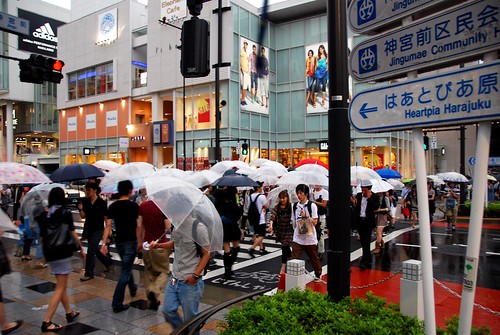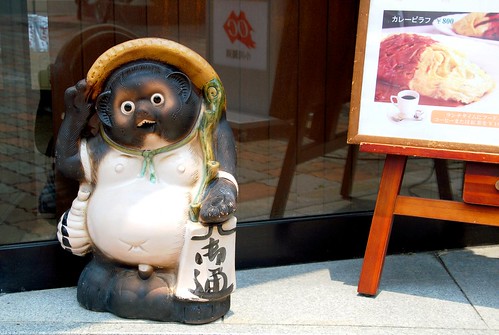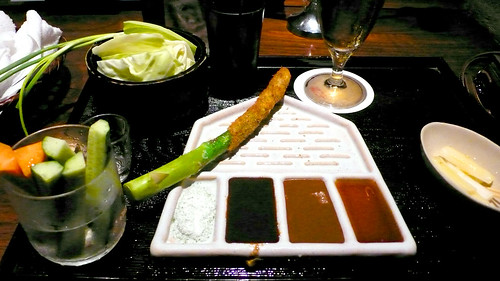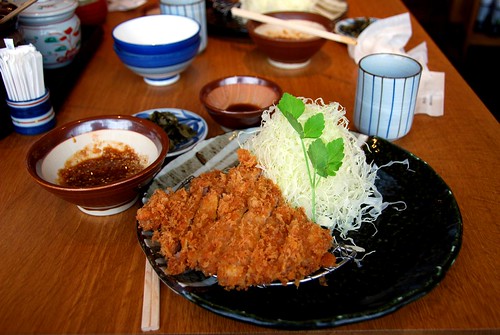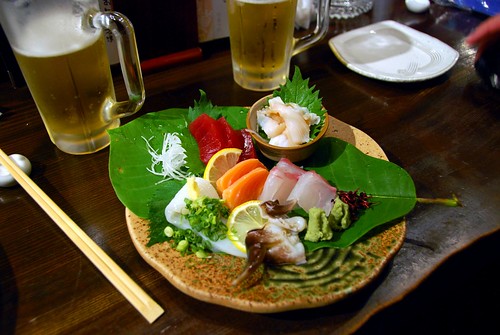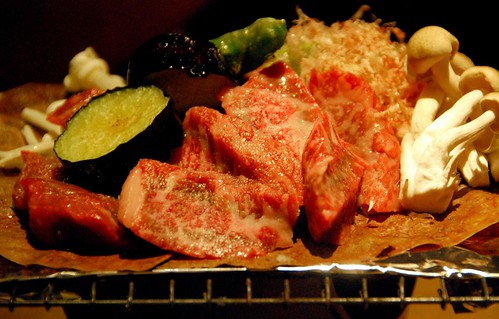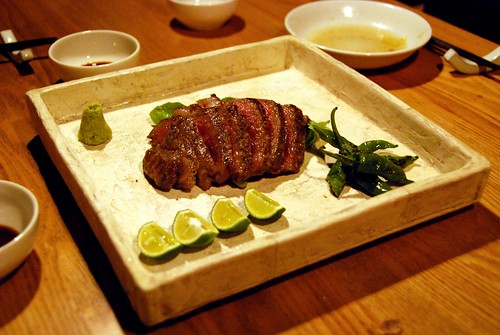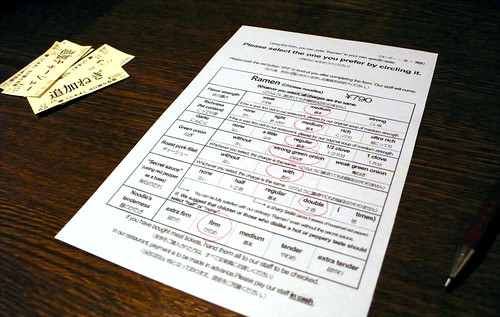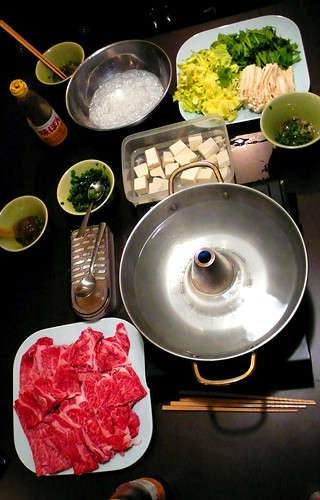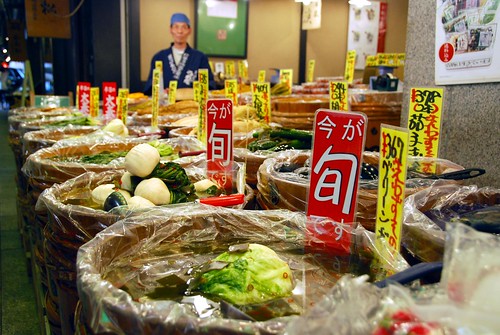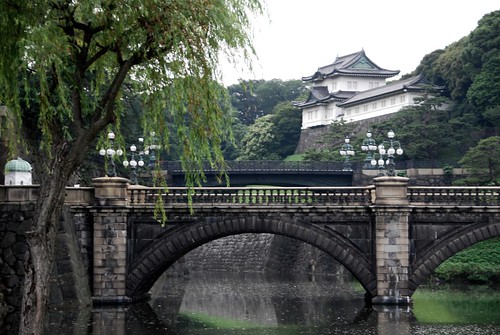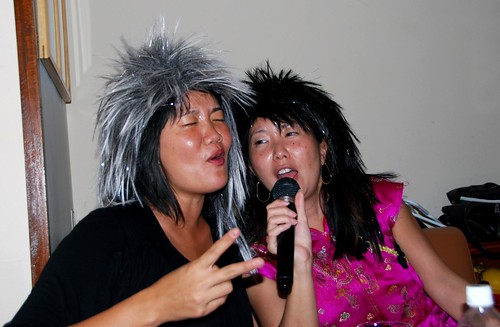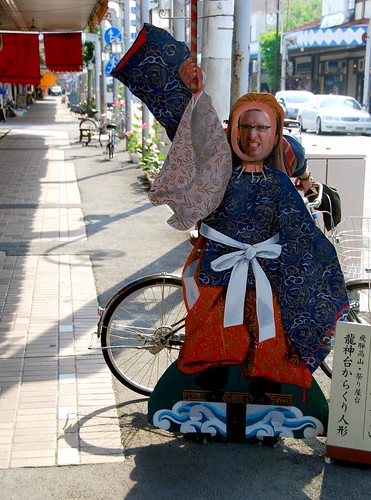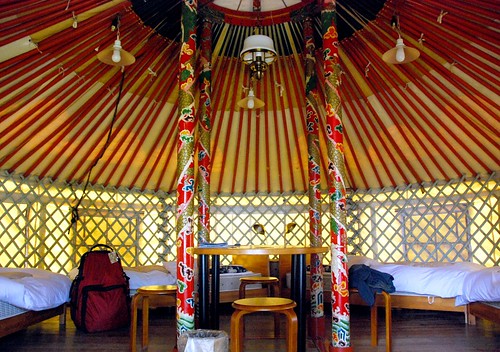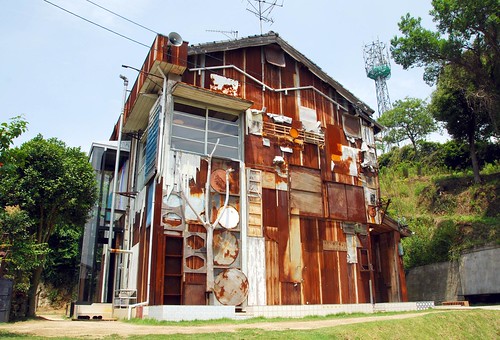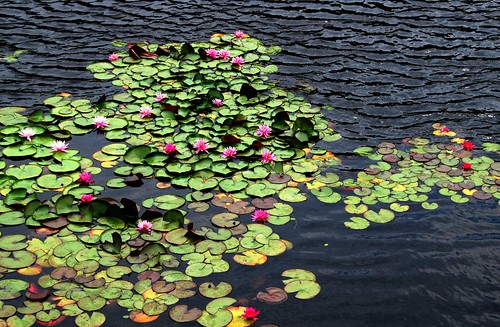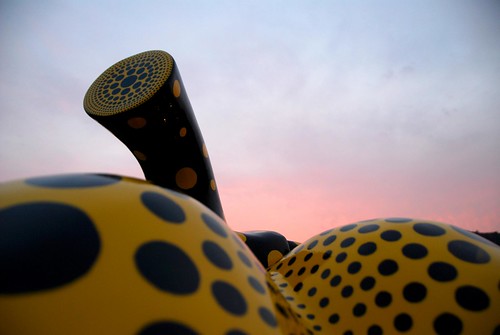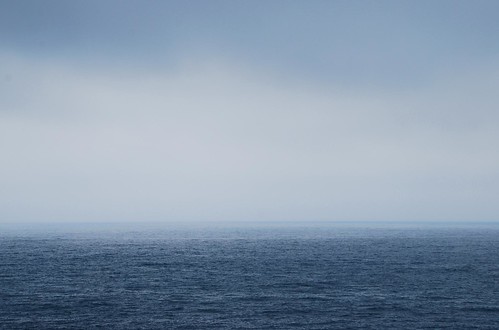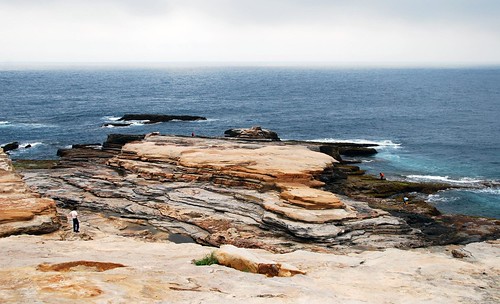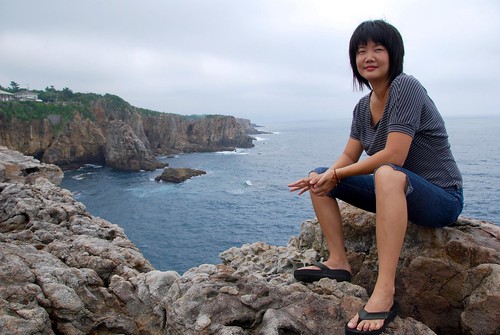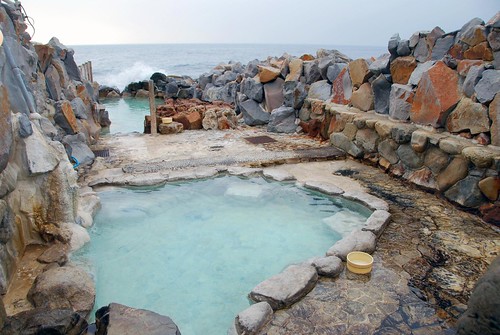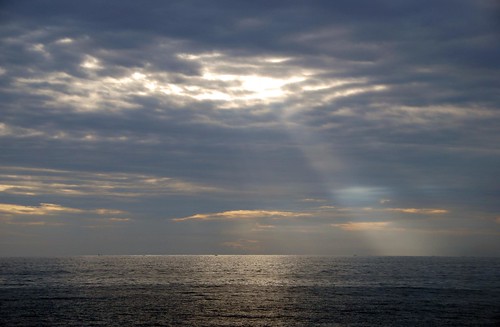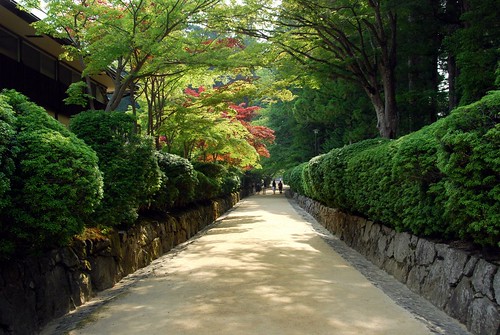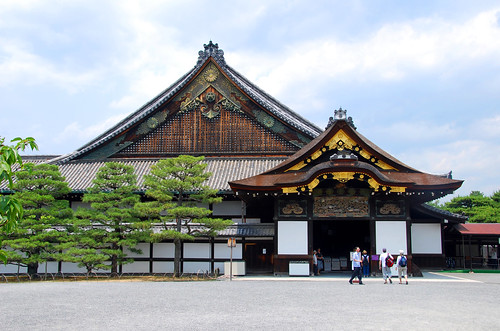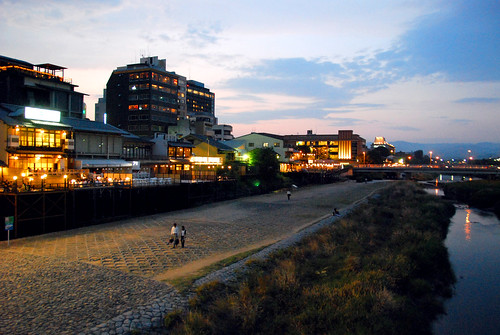Japan
If you like your culture with a dash of comfort, or your peace with a little quiet, then Japan is the name of your travel game. Japan felt like an oasis in the middle of crazy, chaotic Asia, and we found a lot of similarities between the culture here and the one we fell in love with in Taiwan.
Over here at 12FOOT3, Jeremy is the nature lover and I’m the culture vulture, and Japan has got enough to keep us both happy. From fashion, art, style, and design in Tokyo to forests, flowers, and bamboo in Koyasan, (or the intersection of nature and culture in Naoshima), Japan has got it all. Go, and let us know what you think. We’re pretty sure you’ll love it too.
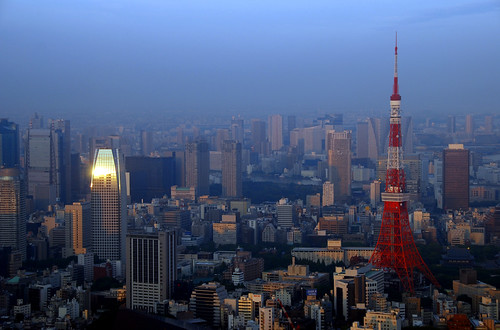
View of Tokyo Tower from the Mori building.
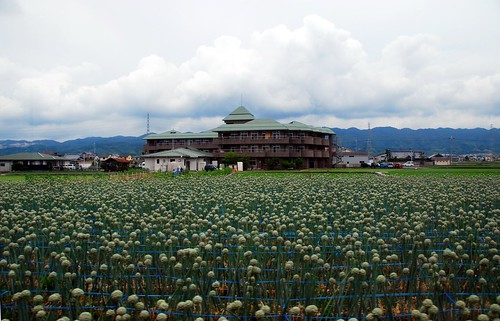
The Japanese countryside, somewhere between Osaka and Naoshima.
Days spent here: 19
Highlights: There wasn’t a place we didn’t like: Tokyo, Kyoto, Koyasan, Naoshima, Takayama—each big city or little town was fabulous in its* own way. Shirahama was a bit resort-y for our tastes, but since we were there before the start of the “official” beach season, it was empty and quiet. That, and the fabulous onsen on the beach, made it worth the trip.
* Hi Adam!
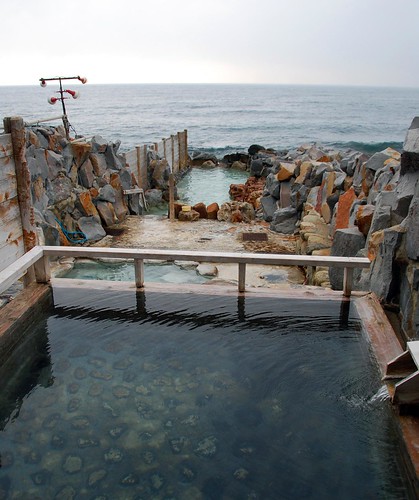
Sakino-yu onsen in Shirahama. The Pacific Ocean crashes over the wall into the cold pool.
Places we would like to visit next time: For us, it’s less about where we’ll go next time and more about when we’ll go. We’ll gladly return to Japan in spring (cherry blossom season), autumn (fall colors painting the Japanese maples), or winter (snow sitting on temple rooftops).
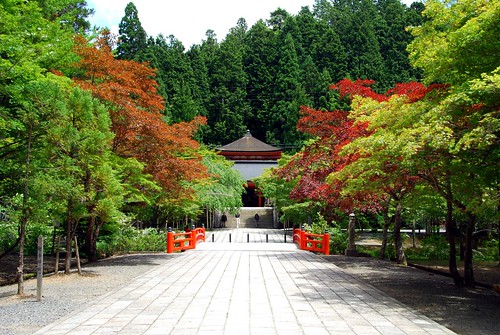
A taste of what autumn in Japan might look like. Taken in Okunoin cemetery, Koyasan.
Average daily expenditures: US$240 (Ouch! Though a good US$50 a day was due to our JR Rail passes.)
Prices: Yup, Japan is expensive. Food is expensive, accommodation is expensive (see the accommodation section below to find out why), and public transport is…guess what? Expensive. In return for parting with your hard-earned cash, you get fabulous food, a high level of comfort and cleanliness in the guest houses, and some of the fastest, easiest, and most convenient transport experiences you can find in this world. In other words, you get what you pay for in Japan. But be prepared to pay a lot.
Weather: We were traveling in Japan during the supposed “rainy season” (June), though it only rained hard twice (and then boy did it rain!). Most days were overcast, humid, but not too hot (maybe mid-70s to 80s?).
Language: Hey you out there! Yeah, you…the one who thinks all Asians look alike and wouldn’t be able to tell a Beijing babe from a Tokyo Tomo. Well, guess what? You’re off the hook for cultural insensitivity, because apparently Asians think all Asians look alike too. EVERYONE in Japan thought I was Japanese and would rattle on to me for several minutes before they caught on to my blank stare. I would have the following conversation with at least one Japanese person every day:
Japanese Person: Irashaimase! Tekka tekka tekka tekka tekka HAI! Tekka HAI! Tekka tekka tekka HAI!
Hope: Uh, watashi wa…
JP: [waiting patiently]
H: …nihongo ga…
JP: [still waiting patiently]
H: …wakari masen*. (Translation: “Um…I don’t understand Japanese”)
JP: Oooaawwaahh**! HAI!
* I had to learn this phrase immediately upon leaving Tokyo.
** Japanese people make the most amazing sound effects.
Food: Yo, it’s good.
One thing I forgot to mention in my food post—some of you are probably wondering what the deal is with the $40 melon or the $60 grapes you hear so much about. It’s not like Japanese people have to take out a second mortgage in order to eat fruit. Rather, these are gift items—a $40 melon is a token that shows your appreciation for the receiver of said fruit. See, everyone knows that THAT is the $40 melon, and the receiver will know it too.
Accommodation: A big chunk of your travel budget in Japan will go towards accommodation. Why? Well, in Japan, rather than paying for a room, you pay by the person. So if you are a single person traveling, you might get a room to yourself for ¥4000 (about US$40). But a couple staying in a similar room will have to pay ¥8000. That’s just the way they do things in Japan. Them’s the breaks.
Budget places tend to run between ¥3000 to ¥4000 (US$30-40) per person per night. So even a budget hotel will cost a couple US$80 per night. For that reason, Tokyo and Kyoto are a good place to try to use miles on hotels if your mileage program will let you do so, because housing is extra expensive in the big cities. You can also try JAPANiCAN, which often has great deals on accommodation.
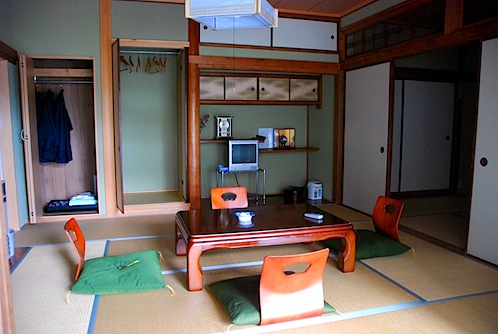
A typical Japanese-style room (though this one is quite spacious).
If you’re traveling on a budget, you’ll want to look for shukubo (temple lodgings), kokumin shukusha (”people’s lodges”), and minshuku (the Japanese version of bed and breakfast, downmarket from the fabulous ryokan). Sometimes a minshuku will offer you a choice of Western or Japanese-style room. We always opted for the Japanese-style accommodation, which means your room will have tatami mats, a small coffee table surrounded by cushions or chairs (like the one pictured above), your bed will be a futon mattress stored in the closet and brought out at night, and your pillow will be stuffed with buckwheat.
Again, despite the high costs, you will get quality from Japanese hotels and guest houses—your room will come with a cute kimono-style robe, a tea set and hot water heater, and (if you stay in the Super Hotel in Kyoto) your choice of pillows (buckwheat, memory foam, or feather, of different densities and thicknesses). Plus a little Japanese atmosphere to boot if you choose the local style accommodation.
Transit: Japan’s national rail system is really, really amazing. You can get to every corner of the country…and often at no additional cost if you spring for the JR Rail Pass. Granted, the pass is not cheap, but you definitely get what you pay for. The trains are super fast, efficient, ultra clean, and comfortable.

On the train from Takayama to Tokyo.
I know that Tokyo’s Metro is supposedly a transit lover’s dream come true, but we found it hard to navigate at times (seriously, the maps look like a pile of multi-colored noodles!).
Internet: As we’ve come to find on our travels so far, Japan adheres to the unwritten international commandment of “developed countries shall be stingy with their wifi.” If our guest house did not have wifi, we could sometimes find an unlocked connection on the street. Of course, my iPod Touch chose to break down in this country, which made it even harder to keep up with friends and family back home. I ended up buying a new iTouch in Tokyo (interestingly, one of the cheapest places in the world to get one…but only by a little bit).
Culture: What you’ve heard about Japan is true—people are exceedingly polite. But Japan is also a rules-based society, and as our hosts Joy and Alex explained, you can ask a person for directions and they are so polite that they walk you to your destination—but ask them to do anything (ANYTHING!) that is against the rules or the process, and you’re in for a long struggle. Put the mustard on the side? Substitute lettuce for tomato? I don’t think so, Mr. Big Shot Rule-Breaker Man! The problem is, again, Japanese people are so polite that they won’t just come right out and say “no.” Instead, they’ll talk around it…you’ll get answers like: “that might be difficult” or “um, I will need to ask if that is possible.” This cultural trait generally does not affect visitors much, but I imagine if you are a Westerner working in Japan (as Joy and Alex are), this can be really frustrating.

Schoolkids in Koyasan. Don’t they already look like good citizens? ![]()
The other insight our ex-pat friends shared with us: you don’t want to be around when a repressed Japanese person finally goes postal. Japan is exceedingly safe, but Joy admitted that the one time she ever feels scared in Japan is when someone is losing it. We saw a guy in Tokyo try to run another guy over at least 3 times (they were having some sort of argument).
The following video is really only tangentially related to the above topic, but it’s pretty funny so I thought I’d share:
The point of this “game” is to pop the other kids’ balloons mounted on their side of their helmet. WITH A STICK. About 12 seconds into the video, you can see one kid fall down and then all all the other kids start wailing on him/her.
The other well-documented aspect of Japanese culture is their obsession with the absurd. You’ve probably seen many examples of this, from Japanese game shows to useless inventions, etc. But the cutest example of Japanese weirdness has to be the raccoon dog. These little statues are everywhere, and they are called tanuki, a mythical creature that is jolly and mischievous. Our campsite in Naoshima even had a sign telling the raccoon dogs not to eat shoes or steal food (wish I took a picture of that)
Tanuki are characterized by their big pot bellies and get this—their humorously large testicles. I am not joking—there is even a schoolyard song about them:
Tan Tan Tanuki no kintama wa,
Kaze mo nai no ni,
Bura bura
Roughly translated, this means “Tan-tan-tanuki’s testicles, there isn’t even any wind but still go swing-swing-swing.”
I got all this from the Wiki entry so it MUST be true.
In short: It’s really, really lovely in Japan.
Let’s get one thing straight right off the bat: Japanese food is amazing. For any foodie whose palette prefers the fresh over the rich and the pleasure of a perfectly ripe vegetable over the heaviness of a cream sauce, Japan is your culinary heaven. (Though they do have some pretty rich dishes too…ramen, I’m looking at you…). Sure, Jeremy and I love Japanese food in the States too, but before coming to the Land of the Rising Sun, we didn’t realize just how bad the Japanese food in San Francisco was. Seriously, compared to the real thing on the other side of the Pacific, San Francisco’s Japanese food is just…sad. And limited too! Who knew there was more to Japanese food than sushi and some salty noodles in broth? Well, we do, now.
Kushi Katsu
This is possibly our favorite type of meal (after sushi) in Japan. Quite simply, it’s fried stuff on sticks. More eloquently, kushi katsu consists of vegetables, fish, and meat, rolled in panko breadcrumbs and fried to a golden perfection for not a minute too long or a second too short. On sticks.
The eating of said stuff-on-sticks is no county-fair dine-and-dash. No, no…kushi katsu dining is quite an experience. A typical menu might look something like this:
Pumpkin: ¥400
Eggplant: ¥800
Squid: ¥1400
Sea Eel: ¥2000
Asparagus: ¥2400
Green onion wrapped in pancetta: ¥3200
etc.
Now, this doesn’t mean that a green onion wrapped in pancetta is US$32, despite what you’ve heard about prices in Japan. Rather, this is a set menu: you start with pumpkin and wherever you stop eating, that’s what you pay for dinner (i.e., if you eat all the items listed above, you pay ¥3200). Along the way, you dip the stuff-on-sticks into a number of different sauces and spices, including parsley salt, mustard, shoyu, some sort of paprika/cayenne mix, and Worcestershire (the Japanese LOVE Worcestershire sauce!). Salad, pickles, and sliced veggies get the same dip treatment and are a refreshing source of roughage for the meal. But the star of the show is the veggies’ fried companions—Jeremy and I just can’t get over how perfectly everything is cooked. We all know how easy it is to overcook something when you’re frying it, but in kushi katsu, the veggies stay crisp and fresh inside their breadcrumb casing, and meat/fish is perfectly tender and done. And, IT’S ON STICKS.
Tonkatsu
This is a pork cutlet rolled in panko breadcrumbs, and then (like kushi kastu), fried to absolute perfection. It comes with a side of finely shredded cabbage, rice, and pickles. Along with the usual shoyu and Worcestershire sauce, you also get a small mortar filled with sesame seeds, which you grind with a pestle and then dump into a sauce mixture. Said sauce mixture is them used to either flavor your deep fried pork, or to dress that finely shredded cabbage.
Sushi and sashimi
This might be the most obvious statement ever made by (wo)mankind, but sushi is really good in Japan. We just didn’t realize how good it as going to be. Saying that the fish is like buttah is actually an insult to the fish. It’s better than butter…it’s more like eating the most perfectly clean, perfectly firm, perfectly tender, creamy, delicious piece of the ocean. And here’s the best-kept secret in Tokyo: sushi for lunch is the best deal you can get. For a few bucks more than a bowl of ramen, (about ¥1100, or US$11), you can get a gorgeous 12-piece sushi set lunch. Your taste buds and you wallet will be equally psyched.
Japanese Wagyu Beef
I think all we need to say about wagyu is that it’s marbled, fatty goodness. We sort of fell in love with Hida beef in Takayama…the photo above shows a special dish from the region wherein some chunks of fatty Hida beef get grilled on top of a magnolia leaf spread with miso paste.
We also had some delicious Kobe in Tokyo, with fresh lime squeezed on top and dipped in salt.
Tempura
Here’s the biggest shock of them all: tempura is serious culinary business in Japan. No, really: it’s considered an art form, and it’s expensive. Any self-respecting tempura chef would want to commit some hari-kari if he saw the limp and batter-sunken veggies that we get in the States. Also, you don’t just get the same old dipping sauce for every piece of tempura. Some items (like the squid I ordered), come with chili powder, salt, and lime. Others come with a curry powder as your dip. It’s all matched to the item in a way that complements the fried interior.
In conclusion: blah blah blah perfectly fried. Blah blah blah crisp veggies blah. Blah tender meat and fish blah blah. Bob Loblaw. You get it, right?
Ramen
Once we left Tokyo (and had to pay for housing), ramen became the meal we ate at least once a day, because it’s cheap and filling. And yet, we never tired of that rich, fatty, salt-bomb. Some ramen shops let you “customize” your bowl of noodles…choosing the doneness of the noodles, the fattiness of the broth, the number of spring onions you want, and the amount of chili powder they throw in on top. Hey it’s Japan, and you can have it your way. We visited a ramen shop in Tokyo where each diner was given a questionnaire when they sat down in their eating booth (imagine an exam stall or a phone booth). It felt like we were taking a ramen test! Spoiler alert: we passed with flying colors.
Even if you don’t get to customize all the different elements of your ramen bowl, you can at least choose the broth. Most self-respecting ramen shops have at least four kinds: shio (salt), tonkotsu (pork bone), shoyu (soy sauce), or miso. By far the best bowl of ramen we had was at Santoka in Kyoto. I had the shoyu broth and Jeremy had the shio…but what made this bowl of noodles a standout was the fatty pork cheek meat. Yes, I said pork cheeks. You can wipe the drool off your keyboard now.
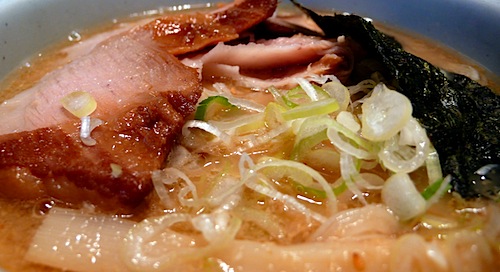
Izakaya
If kushi katsu was our favorite dish (after sushi, which is in a category all it’s own), then izakaya is our favorite type of meal. If ramen is the dish you eat at 3AM after a night of drinking sake, then izakaya is what you eat while you’re drinking said sake. Basically it’s pub food, but of course, the Japanese take it to a whole other level, with inventive dishes like pork stew drizzled with radish puree, or sesame tofu.
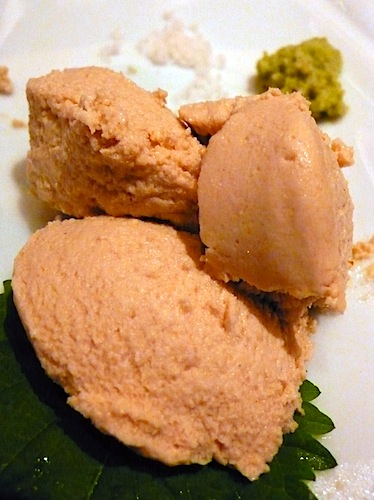
Homemade sesame tofu. Eaten at a fantastic restaurant that may or may not be called Ichi (website is in Japanese, so I can’t tell).
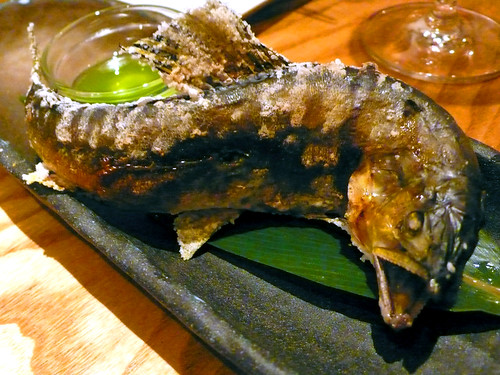
Deep-fried fish, impressively presented. Eaten at yet another amazing izakaya named Kinsai.
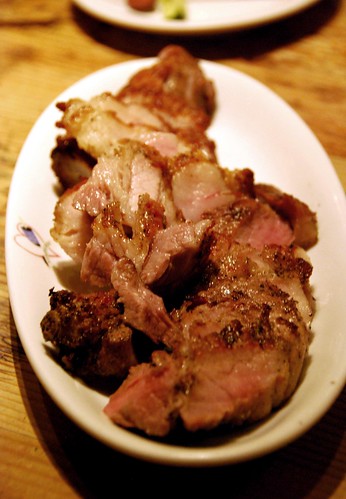
OK, this is just a plate of roasted pork, but we were so impressed with the size of this dish, I just had to include this picture. Eaten at Vinpicoeur.
The point is, it’s varied (so you get to taste a bunch of different stuff), it’s good, and you wash it all down with a cold beer, a shot of sake, or (Joy’s favorite drink) a glass of plum wine mixed with soda water (very refreshing!).
Shabu shabu
I grew up eating Taiwanese-style hot pot for holiday dinners, but I have to say, shabu shabu is different. First of all, the ingredients are cooked in stages: the meat is thrown in the pot first, in order to create a soup base for the vegetables, noodles, and tofu (in Chinese/Taiwanese hot pot, you just throw everything in all at the same time). Second, the meat used is super fatty wagyu beef, which creates a rich, delicious broth very quickly. And finally, instead of dipping your boiled goodies in a raw egg and soy sauce mix (like you do with Taiwanese hotpot), Japanese people grate a radish and add Ponzu sauce as their dipping mixture. I have to admit…Taiwanese hot pot will always hold a special place in my heart, but on taste alone, I think I might prefer the Japanese version (eek…don’t tell the Taiwanese food police!).
In a fit of complete decadence, we ate the above meal as a second dinner in Joy’s apartment while simultaneously watching Tampopo. Is it possible to get more gluttonous? I think not.
Japanese Pickles
Anyone who knows me knows that I love a good pickle. So believe me when I say this: the Japanese KNOW how to pickle. It’s not just that the veggies are perfectly crisp and salted…but there are other, unexpected flavors in the mix too, like a hint of shiso, or a touch of spice. A lovely surprise coming from the land of “we-only-know-how-to-use-dill.”
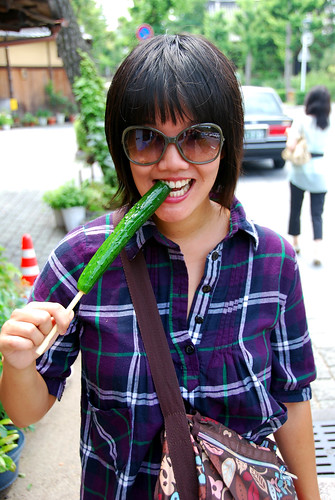
It’s a pickle. On a stick! Taken in Kyoto, Japan.
Japanese Desserts
Japan is famous for it’s Kyoto candies, but we hear they’re usually not actually very good (just pretty). In general, Asians prefer much less sugar in their desserts than Americans do (growing up, the biggest compliment my family could give to a cake was “it’s not too sweet!”). So, Japanese desserts were perfect for my tastebuds.
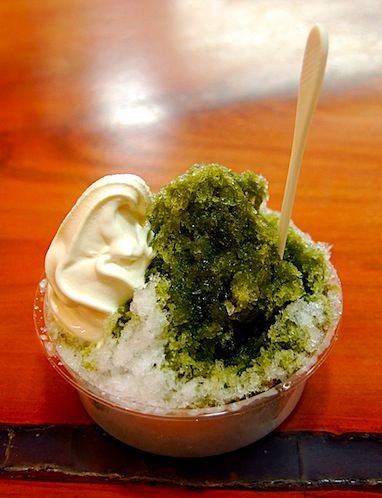
Green tea shaved ice.
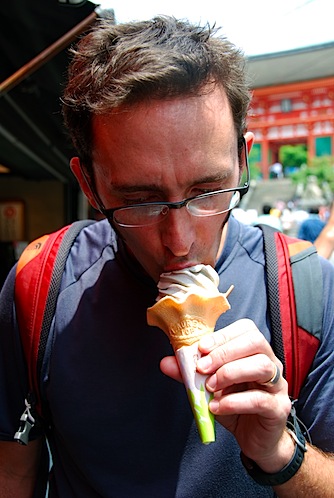
Jeremy eating black sesame ice cream.

Apologies for the bad photo quality, but this thing was too good not to share. It’s called pan-ice, and it’s vanilla ice cream *inside* some slices of french bread. [Drool.] Eaten at Ichi.
The stuff we didn’t take pictures of
Kushiyaki: Grilled stuff on sticks. It’s good, and it’s inventive. Think enoki mushrooms wrapped in pork, spring onions wrapped in pancetta, grilled soy nuts, etc.
Okonomiyaki: The most un-Japanese dish we tried, mostly because it’s really messy. Okonomiyaki is basically an omelette or a pancake, filled with stuff, and then finished with a bunch of toppings, sauces (ahem, Worcestershire), and bonito flakes. We weren’t crazy about this dish, but I don’t think we gave it a fair shot—we only had it at a festival fair booth.
The weird stuff
OK, not everything in Japan is haute cuisine. This one made me scratch my head and think, really?!? Really, Japan?!? Like, for real?
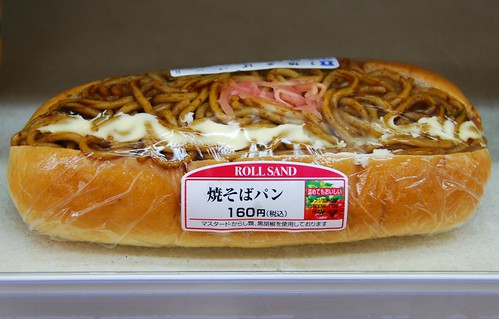
Noodle sandwich with mayo. Yum?
Maybe you can wash it down with some protein water? Or some shiso-flavored Pepsi?
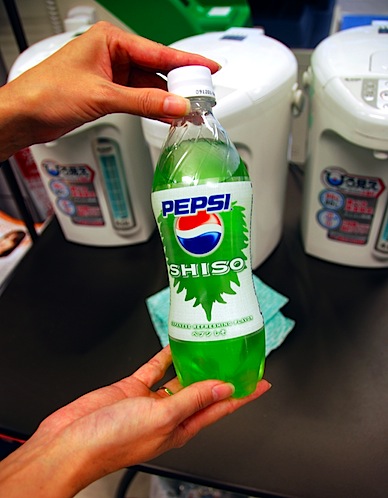
Traveling around-the-world on around-the-world tickets is a really affordable way to do an extended trip…but what you gain monetarily, you lose in convenience. The main restriction is that traveling overland counts as a leg, and since you’re only allowed 16 legs on your trip, it makes sense to try and fly out of the same city you flew into (for example, if we arrived in Japan via Tokyo, but we traveled via train to Osaka and wanted to leave from there, that trip would eat up one of our flights). This restriction only feels like a restriction when you aren’t too crazy about the city you flew into (ahem, Bangkok), but in the case of Tokyo, we were thrilled to get back to see Joy and Alex, eat more yummy food, and soak up some more Japanese culture before heading back to China.
Going back to Tokyo also gave us a chance to walk around the Imperial Palace Park, which we hadn’t done yet:
It also allowed us to squeeze in a few more tasty restaurants. Apparently, after our first stay in Tokyo (and after our hostess found out how much we like eating), Joy started researching reasonably-priced restaurants for us to visit on our return. We had a fabulous meal at a French restaurant that was no larger than a postage stamp but still managed to fit a WHOLE PIG inside their tiny little space:
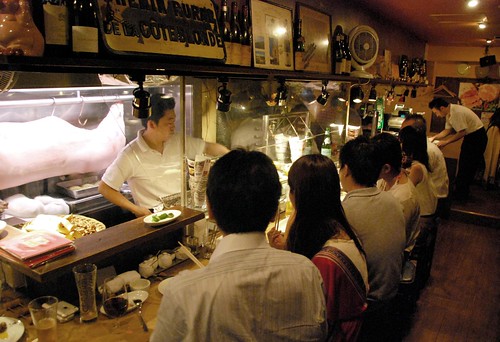
At Vinpicoeur “French Barbecue and Wine” Restaurant (+81 3-6212-1011) in the Ginza district of Tokyo. Yes, that’s a whole pig hanging in the back left of the restaurant.
AND (perhaps most importantly), Joy took us out for karaoke night! WITH COSTUMES!!! Now, if you know my family, you know that the karaoke gene runs deep with the Mengs. My brother goes to karaoke night every week (sometimes twice) in SF, my Dad has owned a laser disc karaoke machine since the early 90’s (with a gold microphone), and J and I had karaoke at our wedding. But if there is anything J and I (ok, *I*) love more than karaoke, it’s costumes. So costumes plus karaoke in one night was like discovering peanut butter and chocolate for the first time. In other words, it was DESTINY.
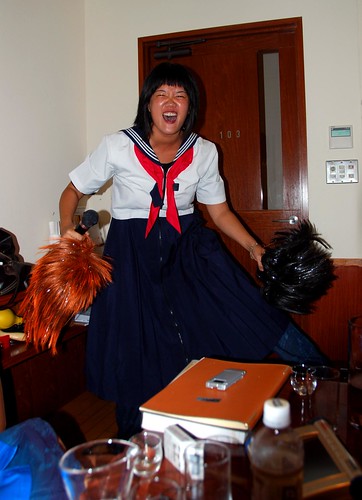
Singing “Hollaback Girl” by Gwen Stefani in a schoolgirl outfit. Why yes, I am using wigs as pom-poms.
Note to the budget-minded: karaoke in Tokyo is definitely not cheap. Those three hours in the karaoke room kinda blew the budget for the day, but it was worth it!
We love Tokyo and could actually imagine living here (if the apartment sizes doubled and the rents were cut by 50% OR if we won the lottery), and that is in no small part due to our amazing hosts. If you ever decide to quit your day jobs, Joy and Alex, you might want to consider teaching classes in hospitality, because you ROCK at it! Thanks for an incredibly tasty, boozy, and most of all, FUN time, Joy and Alex!
“Hey, did you guys hear the news?”
I was sitting in the communal kitchen of Zenkoji temple, another shukubo (temple lodging) where we were laying our heads for a short stay in Takayama, a town near the Japanese Alps. In the kitchen eating breakfast next to me were an American teacher from Connecticut and a young Jewish couple who were new parents. The voice asking us the question belonged to another traveler, who was headed to the train station.
“Michael Jackson just died. Farrah Fawcett, too.”
There were a few “oh, wow”s and some other exclamations of surprise, and then…it was on with the morning conversation about how lovely Japan is.
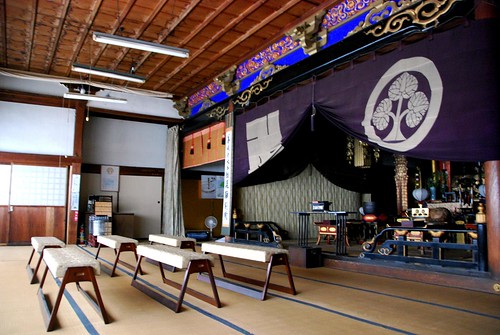
The main altar at Zenkoji temple.
I can remember very clearly where I was when I heard that Princess Diana had passed away (in my college apartment in Berkeley, tying my shoes to go for a run). But in some ways Michael’s death was marked more by what a non-event it was for those travelers in Takayama. Blame our nonchalance on the kind of peaceful acceptance of circumstance that the Japanese countryside inspires, or perhaps it was just remoteness, but Michael Jackson (or anything Hollywood-related, for that matter), felt really, really far away from Takayama.
Some people describe Takayama as a “mini-Kyoto,” and the description feels accurate. The town, though large, feels intimate, with main streets bisected by hidden alleys and lanes, where little gems of restaurants are just waiting to be discovered.

I can’t believe I ate the whole thing! J finishing off a bowl of Hida beef ramen. Mmm…sooo fatty. Sooo good.
The star attraction in Takayama is Hida-no-sato (Hida Folk Village), an “open-air museum” of Japanese farm houses that were moved to this idyllic setting in the 1950s when many of these traditional homes were knocked down to build a dam (seems like China isn’t the only one to displace a bunch of it’s residents for a dam).
We saw many different thatched roof houses and interiors; most floor plans were centered around an interior fire pit that was the center of action in the home.

This is what a old Japanese farm’s toilet looked like.
You know if I lived in the Japanese mountains, I totally would have rocked these hot straw go-go boots:

The Japanese mountain equivalent of Uggs.
We spent the rest of our time exploring the town by foot and bike, riding down narrow streets lined with traditional Japanese houses in the Sanmachi traditional buildings area.
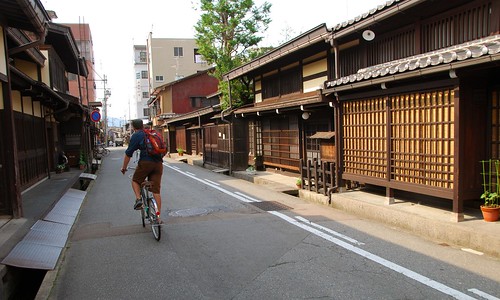
Biking down Furui Machi-nami, a street with many old private Japanese homes.
And Jeremy finally got to indulge his fantasy of being a shogun!
We could have easily stayed a few extra days in Takayama. Next time, we’d like to see nearby Shirakawa-go, which has A-frame houses surrounding a mountain lake. We loved our peaceful time in this idyllic mountain town, and we won’t soon forget where we were when the world lost the King of Pop.
It’s hard to know what to do after a family member’s death, especially when you’re traveling. It doesn’t feel right to dwell on the event, but it doesn’t feel right to just move on to the next town, either. In this way, I feel like Jeremy and I were blessed to be in Japan during Grandpa Bob’s passing. The country is so peaceful that it promotes a meditative quality in it’s visitors (at least, it did for us). Being in Shirahama during Grandpa Bob’s passing was really the second best place on earth we could have been (other than by his side)…something about looking into that deep blue ocean horizon allowed us to process the event and come to terms with our feelings about his death from afar. And our next stop had a similar replenishing effect on our spirits: Naoshima, a small, sleepy island between Honshu and Shikoku, is known for being a public space dedicated to contemporary art. What better way to replenish the soul than to sleep on the beach (in Mongolian yurts, no less), and wander around a sleepy fishing village searching for public art installations?
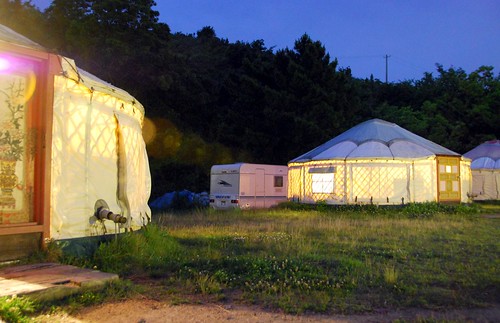
Tsutsuji-so yurt village at night, a Mongolian pao encampment on Naoshima’s swimming beach.
The way that Naoshima expresses its artistic dedication is threefold. First, there are public artworks that can be found all around the island. Our absolute favorite was “Pumpkin” by Yayoi Kusama. It was set up on a dock off the swimming beach, and if the tide is high enough, the dock gets swallowed by the waves, making the pumpkin look as if it is floating on the water.
We weren’t the only ones who loved “Pumpkin.” All day long, kids and adults alike were wandering by, marveling at the piece and leaving with huge smiles on their faces. I’ve seen work by Yayoi Kusama before (easily recognizable by the polka dot theme throughout her work). Even though her pieces tend towards this Pop-y aesthetic, the roots of her work are actually quite dark. Read more about her on Wikipedia: she’s really quite fascinating.
In the Honmura district of Naoshima, there are a number of old Japanese houses that have been renovated by international artists. Known as the Art House Project, there are six different homes scattered around the district that have been gutted and installed with artwork. The most interesting exterior is definitely Haisha house by Shinro Ohtake, which basically looks like a giant collage of found objects:
The interior of Haisha house is also super funky (there is a giant white replica of the Statue of Liberty in one of the rooms). Though the house is visually striking, I am finding myself unimpressed with artwork these days unless it provokes an emotional response. This is something I am reaching for in my own work (not always successfully, but I’m working on it), whether that ideal is expressed through design, or photography, or even textiles. So I sort of ended up walking through Haisha house and marveling at all the stuff, but not really feeling a cohesive message or emotional connection to the work.
One piece that did provoke a more visceral response was “Backside of the Moon” by James Turrell. The building itself was essentially a rectangular box (Japanese minimalism at it’s best) designed by Tadao Ando (I think the building is considered a separate work of art entitled Minamidera). You are led into the pitch black space, and you sit there for about 8 minutes until your eyes adjust to the darkness. After your cones get used to the blackness, a rectangle of light appears in the far wall of the building, and you are allowed to walk towards the light from the back of the room. I found the experience quite interesting, because in the darkness, your depth perception gets thrown completely out of whack…you cannot discern how far away the back wall is, and you can’t feel the size of the space either. Jeremy was rather unimpressed with the piece, but I found it quite powerful. When else are you forced to engage with a work of art like that? When was the last time a piece instilled the opposing feelings of peace and fear in you?
One piece we did agree on was Kadoya house by Tatsuo Miyajima. The entire front room of the house had been turned into a shallow pool with digital LED numbers submerged in the water. Each LED was counting down at a different rate. To me, the pool was almost like a city, with each number representing a person: some moved fast, some moved more slowly, each one at it’s own pace. Jeremy saw the pool as a “primordial sludge,” and I thought this added an extra dimension to my interpretation of the piece. Was Kadoya a representation of evolution, with some species persisting and others burning themselves out? Kind of hard to explain without a visual, huh? Well, it’s a total shame, but you cannot take photos in any of the Art Houses or museums on this little island. For weeks after we left the island, I kept lamenting to Jeremy, “Oh the pictures I could have taken in Naoshima!” Fortunately, I was able to harvest an image of Kadoya from the web, though I don’t think it does the piece justice:

Interior of Kadoya house. Each of those lights in the water is an LED number counting from 0 to 9 at different rates. (image source)
The final and most impressive way in which Naoshima dedicates itself to contemporary art is through it’s museums. There are two on the island: Benesse Art House and Chichu Art Museum. I’m not going to talk much about Benesse House, because Jeremy and I weren’t very impressed with the work there—though it is worth mentioning that you can actually stay at the museum if you’re looking for a way to spend US$500 per night: the upper floor of the galleries is a fancy hotel, with original artworks in each room.
On the other end of the spectrum, Chichu Art Museum is, hands down, the most fantastic museum I’ve ever experienced. It is the most cohesive expression of nature, art, and architecture I’ve ever seen. Again, no photos were allowed in the museum (”Oh the pictures I could have taken in Naoshima!”), but I’ll do my best to describe it along with some photos I’ve found on Flickr.
First, the building itself: Tadao Ando designed a super sleek, modernist concrete building into the side of a mountain. You might think that the minimalism of modern architecture would be too severe against the beauty of the Japanese countryside, but the architect has managed to instead create these indoor/outdoor spaces where the building is framing, rather than containing the nature around it.
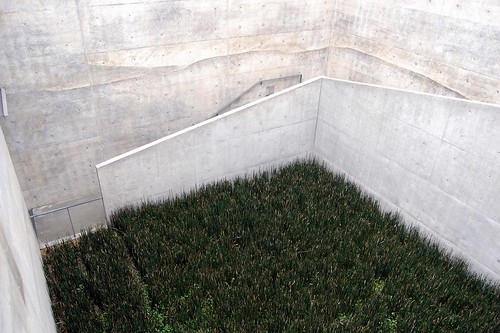
A small courtyard with bamboo shoots. The way these walls framed the sky was fantastic too. (image source)

“Open Sky” by James Turrell. (image source)
Second, the artwork: there are only 9 pieces in the entire building (not counting the building itself) made by 3 different artists: Claude Monet (5 paintings from the Waterlilies series), James Turrell (3 pieces), and Walter de Maria (1 installation). The Monet paintings are the only pieces not made specifically to be housed in the building, but in the case of this artist, the building was made to house the Monets. Now, let’s get one thing straight: I like Monet just fine, but I wouldn’t say that I am excited by his work. But I literally gasped when I walked into the Waterlilies room. Ando has planned it so that as you walk into the space, the largest painting is perfectly framed between two non-load bearing walls. Now THAT’S what you call good interior design: predicting the way a visitor will move through the space, and then rewarding them when they do as you expect. Though the museum is all underground, the rooms are still it by natural light. There is enough space within the gallery so that you can stand far away from the massive paintings, and yet you can also walk up close to observe individual brushstrokes. Ando was clearly a huge fan of the Waterlilies series to treat it with this level of respect. For the first time ever, I witnessed a gallery elevate a piece of art, rather than receding to the background. Any artist would be thrilled to have their work treated with this kind of sensitivity and reverence.
And it wasn’t just the Monet room that thrilled. I also loved Walter de Maria’s installation “Time/Timeless/No Time.”

Walter de Maria’s “Time/Timeless/No Time.” (image source)
Though it might not look like much in the photo, the beauty of this piece is that it is constantly changing. Light shines in through the skylight and reflects off the gold bars along the walls in different ways according to the position of the sun. As the viewer walks through the room, s/he is reflected in the large black ball in the center of the room, creating a lovely fusion between the observer and the observed. Again, nature, art, and architecture work together to make this piece. Without one, there cannot be the others.
Wandering around Naoshima truly replenished our spirits. Though not technically an earthwork, this little island in the middle of the Seto Sea accomplishes what the best earthworks intend to do: force the viewer slow down, observe, and contemplate the way in which humans can elevate our experience of nature. Bravo, Naoshima!
A few more scenes from around Naoshima:
When we told our friends and family that we were going to go through with this 1+ year around-the-world idea, reactions fell all across the spectrum. The great majority of people were supportive, a lot expressed jealousy, but a few seemed concerned. How could we possibly make it a whole year sleeping in a different bed every night? Wouldn’t it be hard eating restaurant food all the time? Wouldn’t we miss our house, a place to call home?
Of course, I was scared of all these things too before we left. It has been really interesting being on the road and realizing that all those things you think you need, you really don’t. Sure, we miss a few things: Jeremy misses his bike, and I miss my sewing machine (and my closet) (ok, and my shoes). But most days we enjoy the simplicity of living out of a bag and we don’t miss THAT much about San Francisco.
Except our family and friends. (OK, and maybe Mission burritos.)
We’ve had a couple of people tell us that we were “brave” for going on this trip, and while I can see where they are coming from, I think that far and away the most courageous thing we’ve done is to find peace with the fact that we will be missing out on 1+ year of our friends’ and families’ lives. Many of our friends at home are having babies or getting pregnant and of course we want to share in those life-changing experiences with them. Both Jeremy and I have ailing grandparents and every moment we spend with them is precious. We knew what we would be missing out on and yet, we still left. We left with only the conviction that this trip was the right thing for us to do at the right time. We left knowing that we would be stealing time from our friends and family but feeling certain that the quality of what we would be able to give them when we came back would be greater. I can think of no “braver” act than that on this trip (even eating the hairy cow rumen). Inertia can be a powerful thing to overcome.
All of this came to a head in Shirahama, a beach town south of Osaka that faces the Pacific Ocean. We decided to go there on a whim…we hadn’t planned to see the coast at all, but we read that there was a nice beach there with an outdoor onsen (mineral hot spring), and since we could get there free using our Japan Rail passes, we decided to go for it.
Since we hadn’t really planned on visiting Shirahama, we didn’t have accommodation booked, but luckily the train station had a tourist information center that could help us. I was busy working with the nice lady at the counter when Jeremy turned to me with his sad face (and if you haven’t seen Jeremy’s sad face, it is really heartbreaking).
Jeremy’s Grandpa Bob, an incredible man who, up until his late 80’s, was still bodysurfing in the Pacific, had passed away.
Fighting back tears (rather unsuccessfully, I might add), we booked a room for the night and boarded the town bus towards our minshuku (Japanese B&B). I’ll tell you what, of all the bumpy, sweaty, scary, torturously long bus rides we’ve endured on the trip thus far, there was never a harder transport moment than those 10 minutes it took us to get from the train station to our B&B, trying to hold it together until we got to the privacy of our room.
There is something poetic about the fact that we had come to Shirahama, a town facing the Pacific Ocean, surely the last ocean that Grandpa Bob—a lifelong lover of the beach—last swam in. When I look at the photos of our time in Shirahama, I see only his presence.
He was with us when we walked on Senjo-jiki (a.k.a. Thousand Tatami Mat Point—locals think the rocks are so wide and flat that they look like a thousand tatami mats all strung together)…
He was with us when we wandered around Sandan-heki (Three Step Cliff)…
He was with us when we soaked in the waters of Sakino-yu onsen, a hot spring on the beach with ocean waves crashing into the cold pool…
He was with us when we swam in the Pacific…
And he was definitely with us as we watched the sun lower over that very same ocean…
Grandpa Bob died at the age of 93, surrounded by all three of his children and some of his grandchildren. His passing, as his life, was full of grace and beauty. We love you, Grandpa Bob.
It’s 6 o’clock in the AM, it’s cold, I’m hungry, and my hips are sore from sitting Indian style for an hour first thing in the morning. Why am I doing this to myself? Because we’re staying at Haryoin Buddhist Temple in Koyasan, a holy mountain retreat area in Japan, and we’ve decided to drag ourselves out of bed at the crack of dawn to witness the temple’s morning prayer. Buddhism is all about suffering, isn’t it? ![]()
Located south of Osaka, Koyasan has 117 subtemples stuffed into 10 square kilometers. If you think that sounds amazing, you’d be right. I have no idea if Koyasan is on the typical Japan tourist route (we heard about it from a Japanese friend—thanks Tomo!!!), but we didn’t see that many other Western tourists while we were here—but we did see loads of Japanese pilgrims, dressed all in white (some wearing bells), wandering from temple to temple and chanting prayers at each stop along the way.
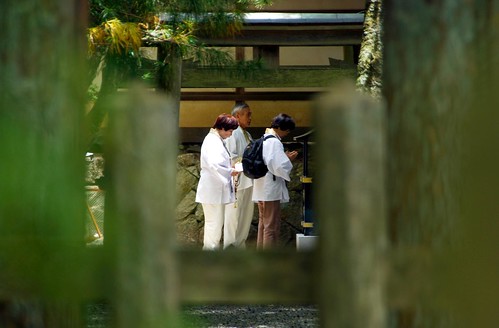
Japanese pilgrims praying at a temple in Koyasan.
And my goodness, what temples they are! Even more stunning than Kyoto, possibly. Even if you don’t know the first thing about Buddhism, the gorgeous natural surroundings, the awe-inspiring temples and pagodas, and the peaceful disposition of the place will conspire to adjust even the most distracted psyche into a state of mindful consciousness.
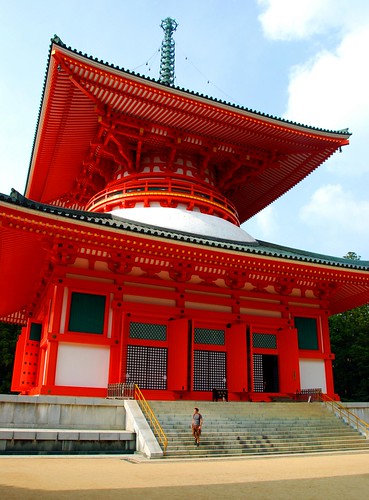
Konpo Daito in Dai Gaan temple complex. There were 5 giant golden Buddhas inside, but unfortunately, you are not allowed to take photos inside Japanese temples. To get an idea of the scale of this thing, look on the steps in front of the temple—yes, that’s Jeremy.

This is Jeremy’s favorite pagoda. Also located within the Dai Garan temple complex. Didn’t I mention that the Japanese can do amazing things with natural wood? ![]()
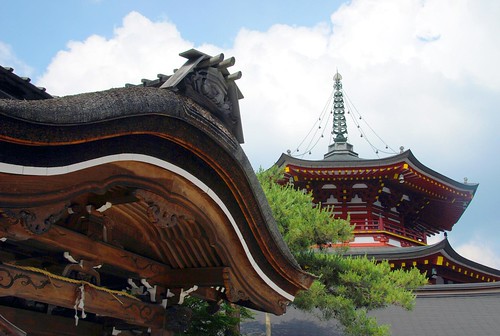
Unfortunately, I don’t remember what this temple is called! We wandered in off the main street through Koyasan.
Up until 1916, women pilgrims were not allowed into Koyasan, so devout females had to hike a 10 km circuit around the holy mountain area with the hope of glimpsing some of it’s gorgeous temples. Jeremy and I hiked the circuit, which climbs up and down three different 3000 foot mountains and includes many small shrines along the way. It was not a super tough hike, but it was no walk in the park either, and you had to respect these women pilgrims for heir tenacity and devotion. Buddhism is also about mental and physical discipline, right? ![]()
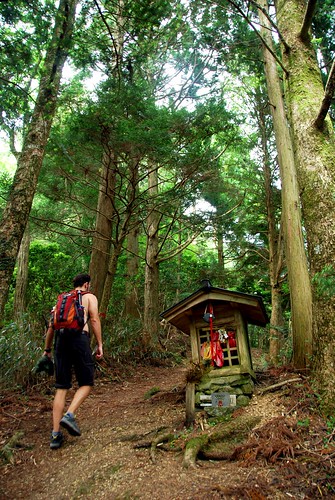
J hiking by a small shrine on Mt. Mani (the first mountain on the Women’s Pilgrim route).
Today, the women’s pilgrim route begins in Okunoin, the most amazing cemetery Jeremy and I have ever seen. Wandering through a cemetery may sound creepy, but it wasn’t at all. Perhaps it’s because Buddhists see death differently than we do in the West…or perhaps it was just the incredible forest growing in and around and over all the gravestones. With over half a million (!!!) tombs in this cemetery, that’s no small feat for this forest.

Jeremy wandering part of Okunoin’s 2km-long sando (entry path).

Okunoin’s Torodo (Lantern Hall). There were literlally thousands of lanterns in this room organized in tall shelves with narrow walkways. It felt like a library full of souls.
There’s something very comforting about seeing nature swallow up these gravestones and markers. Again, even if you didn’t know the first thing about Buddhism, Okunoin is enough to convince even the most morbid mind that death can be a thing of beauty.
As I mentioned above, Jeremy and I were staying in Haryoin Temple on Koyasan, and one of the common things to do in shukubo (temple lodging) is to eat shojin ryori, a vegetarian meal that is prepared in the temple. It was tasty, though at 2100 yen (US$21) per person, it was definitely not in the budget for both nights.
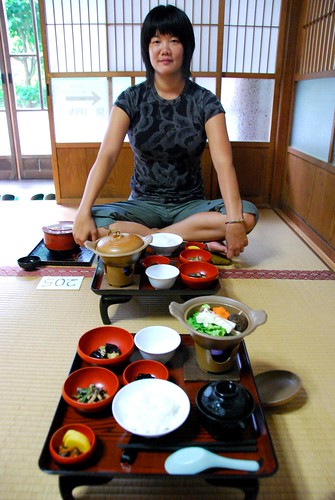
Our shojin ryori dinner at Haryoin.
Our room at Haryoin was the first traditional Japanese style room we stayed in, with a tatami mat floor and futons stored in the closet, to be brought out when you are ready for bed. Though it can be a pain to put your bed away in the morning and take it out at night, we did like how versatile it made the space.
The one thing Jeremy could not deal with at all was the shoe thing. See, Japanese people do not wear their outdoor shoes inside…instead, they take off their shoes and step onto a slatted wood mat to put on their inside slippers. Most places don’t mind if you just walk around in your socks, but Haryoin sort of insisted that we wear the inside slippers. But of course, you cannot wear the slippers on the tatami mat, so you have to take the slippers off before entering your room. To top it all off, there is a separate pair of slippers that you wear in the bathroom. So if you came back to your room from a day of wandering around Koyasan and then went to the bathroom, you would have to take off your outdoor shoes, put on your slippers, go to your room, take off the slippers, put the slippers on again when you leave your room, walk down the hall to the bathroom, take the slippers off, and then put on the bathroom slippers. The Japanese put the “orient” in “process oriented.”
And what can I say about that morning prayer ceremony? Well, it’s not what we expected, that’s for sure. We sort of thought that there would be some bell-ringing and some interactive chanting involved, but Haryoin’s morning prayer involves none of that. Rather, two monks pray out loud for about 30 minutes and then light various candles, eventually culminating in a roaring fire in a metal bowl (which required one monk to get up and turn on the air vent to suck the smoke out of the room). We didn’t understand a word, since it was all in Japanese, and unfortunately, we couldn’t see much either, since we were seated on tatami mats and the altar was raised up on a stage of sorts behind tall screens. Quite frankly, we’re still sort of baffled by the whole thing.
It’s ironic that the spoken ceremony did little to reveal any further insight into Buddhism, but walking around Dai Garan and Okunoin communicated volumes to us. Or…perhaps it’s not ironic at all to learn about Buddhism through observation and experience rather than through the spoken? Buddhism is also about silent meditation, is it not? ![]()
Here’s a convoluted statement for you: there are many reasons why Kyoto is amazing, and one of those reasons is simply because there are so many reasons! To clarify: the variety of things to do and environments to explore in this city is just astonishing. Urban life? Check. Temples? We covered that in the last post. Gardens? Yessiree. Markets? You betcha. Castles? Heck Yeah. Public parks? Yup. Good food? Well, of course, it’s Japan!
One of the (many) cool things we saw in Kyoto was Nijo-jo Castle. There really is something ancient about the place, and walking through the castle and grounds makes you feel like you’ve traveled back through time as an old Shogun.
Nijo-jo is famous for one thing: creaky floors. Seriously, they’ve actually engineered the floorboards to squeak so that bandits and perhaps a bitter feudal lord couldn’t sneak in to attack the Shogun housed within. It’s quite interesting to be walking along the palace interior in your socks (you have to take off your shoes whenever you enter any interior space in Japan), and having the ground sing underneath your feet. In fact, they’ve dubbed it “The Nightingale Floor,” and here’s how it works:
After experiencing Kyoto of the past, you can check out it’s present. Nishiki food market is a fun place to wile away an afternoon, checking out all the amazing foodstuffs that Japan has to offer. We ate tofu donuts (good!), saw hundreds of different types of Japanese pickles, and gawked at knives that cost more than some peoples’ monthly rent in San Francisco.
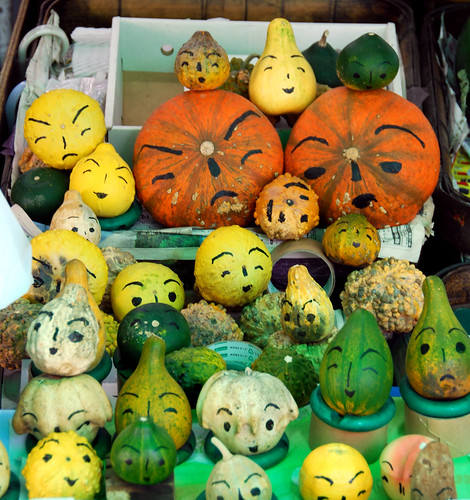
The many faces of squash. Taken in Kyoto’s Nishiki food market.
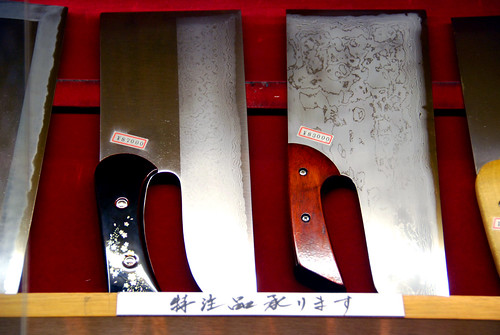
OK, this particular photo was taken in Tokyo, but we saw similar knives in Kyoto. These bad boys are specifically made to cut noodles. And at 84,000 yen a pop (about US$840), you’d have to cut a LOT of noodles to make this purchase worthwhile.
For an already green city, Kyoto also has some beautiful parks, where you can enjoy even more greenery. I can only imagine how jaw-droppingly beautiful Kyoto would be when the leaves are turning in the fall. Jeremy and I have already decided that we need to come back in the autumn (when all the Japanese maple leaves turn red), in the spring (when the cherry blossoms go off), and in the winter (when everything is covered in a blanket of white).
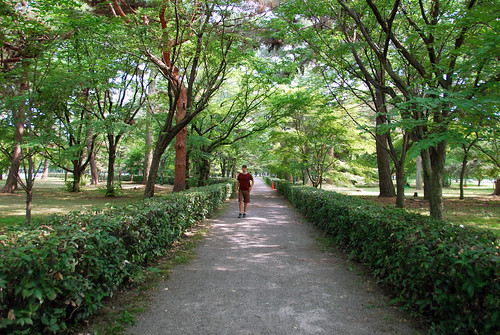
Strolling through the Imperial Palace Park.
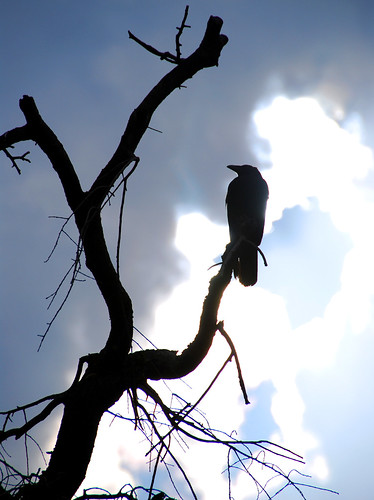
There are ravens all over Japan. This one was perched at the top of a famous cherry tree in the middle of Maruyama Park—a tree that is apparently so beautiful when it blossoms that you have to view it from the hills in the back of the park because there are so many visitors mobbing the area. Unfortunately, the tree was looking kind of sad when we were there (in the summer).
Since we no longer had the benefit of a place to stay in Kyoto, we had to watch our budget a little more closely when it came to food. This turned out not to be too much of a problem, since there are some incredible (and affordable) ramen joints in Kyoto. Our favorite was a place called Santoka, which had a surprisingly hip and modern interior. But it wasn’t the decor that kept us coming back for more…it was the pork cheeks. Behold this bowl full of fatty, delicious beauty!!!

Even with the wealth of attractions in Kyoto, our favorite thing to do was just to walk. There is so much to see in the city’s narrow pedestrian alleyways…
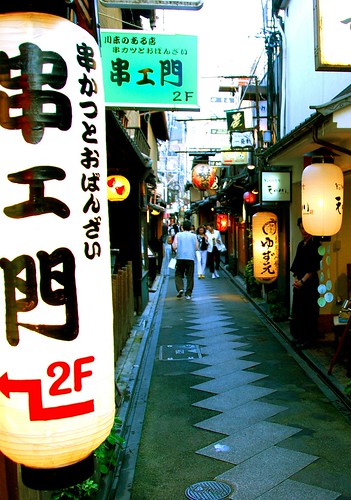
Pontocho Street, where Geisha often entertain at night in the exclusive clubs.
…or when you’re strolling by the river…
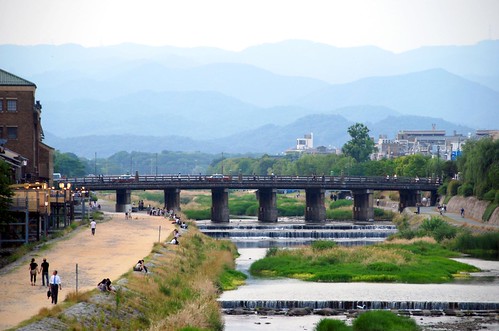
The Kamo River…look at those mountains in the background!
…or wandering in and out of temples.
In short, we love Kyoto. Maybe we’ll see you here next fall…or winter…or spring…or…?
Picture it: It’s sundown, and Hope and Jeremy are walking down a Hanamikoji, a ridiculously picturesque cobblestone street in Kyoto. The street is lined with tea houses and exclusive restaurants, and all of the buildings are constructed in the traditional Japanese style, with thin wood slats backed by rice paper screens. Hand-dyed noren (Japanese split door curtains) flap in the slight breeze, exposing tatami-matted interiors where geisha entertain Japanese businessmen until the wee hours of the morn.
Hope: Can you believe how gorgeous Kyoto is?!?
Jeremy: Yeah, it really is.
Hope: Beautiful.
Jeremy: …
Hope: Hmm…I wonder how expensive this restaurant is? [Studies menu furiously.]
Jeremy: Hope! Hope!!!
[Geisha enters and exits scene. The sound of wooden sandals clacking against pavement fades out.]
And that’s how I missed our one and only geisha sighting in Kyoto.
We were completely set up for the shot—she was walking directly towards us, and had I been paying attention, rather than looking at the menu (the stupid menu!), I would have been able to take at least 2 photos of her before she passed. Yes, it was very depressing, but I felt even more sad for the poor geisha, who had at least 5 tourists literally running after her, trying to take her photo. This made me feel better about not getting my own shot—the poor gal probably feels that she’s been documented enough, thankyouverymuch.
Oh well, on the bright side, it’s hard to stay depressed in Kyoto. Man, is it beautiful here! To be fair, Kyoto is a big city, so if you ever make it out this neck of the planet, don’t expect to step off the train and into a scene like the one described above. You do have to deal with a bit of urban sprawl. But the delightful thing about Kyoto is that between all those congested city streets is a charming and vibrant town of cobblestoned pedestrian walkways, Japanese teahouses, and a myriad of other cultural treasures, just waiting to be discovered. For a big city, Kyoto feels like an intimate little town, and a quaint and traditional one at that.

Women in yukata (summer kimono) walking on one of Kyoto’s most atmospheric streets, Sannen-zaka.
Temple-exploring is the name of the game in Kyoto, and we were happy to oblige.
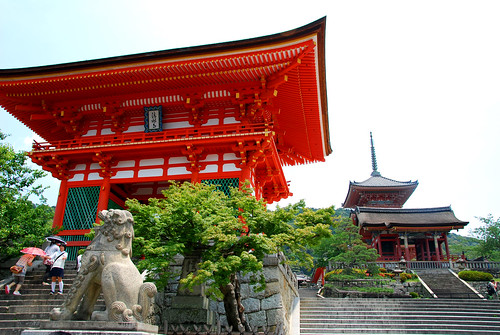
One of the most famous temples in Kyoto, Kiyomizu-dera. Perched in the eastern Higashiyama mountains, it offers gorgeous views of the city.
It has been really cool to see the differences between Buddhism across Asia, and how local culture gets infused into the architecture of the temples and the way in which people worship. Japanese temples are all about natural wood highlighted with gold accents—compare this with highly decorated Chinese Buddhist temples (like Kek Lok Si Temple in Malaysia), or the gilded surfaces of Laotian temples (like those in Luang Prabang), and you’ll see how differently Buddhist devotion is expressed across this continent. I have to say, the natural wood and simplicity of Japanese temples is really quite appealing, and makes the few gilded surfaces and colorful accents stand out more since there isn’t SO much to look at.
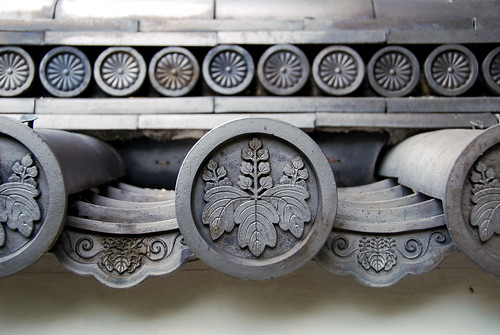
Detail of a temple’s roof tiles.
In Japan, we notice a few differences in the way that people worship as well. You will usually see a small fountain of running water at the entrance to a temple…you are meant to scoop the water out of the fountain to wash your hands before you enter, as these schoolkids are doing below:
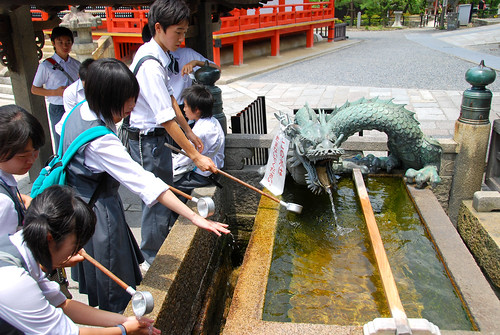
Schoolkids washing their hands before entering Kiyomizudera.
Second, there seems to be some sort of bell-ringing ritual in Japan…usually a bell is hung at the top of an altar, with thick, beautiful rope running from the bell all the way to the floor. Worshippers can ring this bell (usually after they throw a coin into a slotted donation box). This is pretty different from other Buddhist worship we’ve seen, where bell ringing seems to be done exclusively by monks.
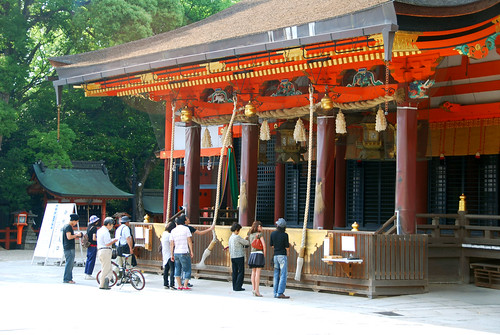
Worshippers ringing the bell in front of Yasaka-jinja.
We also see these folded paper strips dangling off the roofs of many temples…and they are so beautiful and simple that it seems like there must be some sort of metaphor behind them.
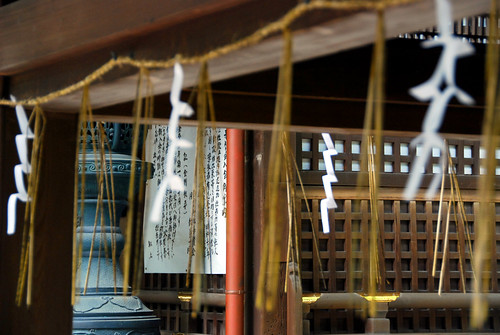
Folded paper strips hanging off the roof of a small shrine we encountered in the middle of the Imperial Palace Park.
Finally, we’re not sure what this is all about, but Japanese people put little aprons (and sometimes wee little hats) on all the stone figures scattered around a temples’ grounds. Are they trying to clothe the statues so they aren’t hanging out there in the open with everything exposed? Keep them warm? We have no idea! But it’s pretty cute, and delightfully Japanese.
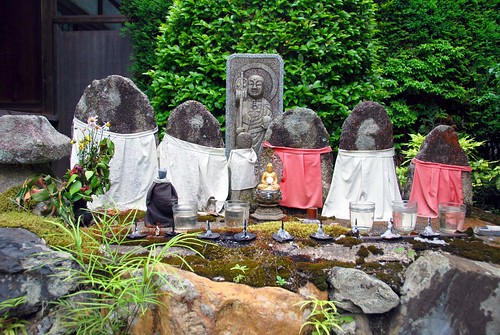
Stone figures covered modestly in aprons near Kotoku-an.
But Kyoto isn’t only about temples…there are also some incredible gardens that you can stroll through, admiring the beauty and appreciating the silence.
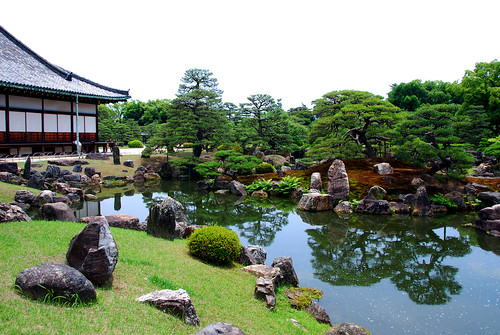
The gardens outside of Nijo-jo Castle.
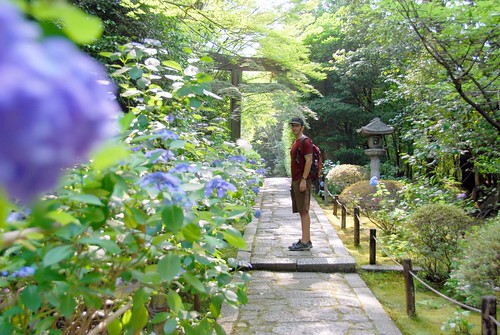
We were in Japan while the hydrangeas were going off, shown here in the gardens of Konchi-in.
If the temples and gardens weren’t enough to make your heart skip a beat, the city is freakin’ gorgeous too. Most nights, we walked along the Kamo River around sunset, which has tons of outdoor restaurants/bars lining it’s western bank. If, like us, you don’t want to pay the inflated prices along this picturesque stretch of water, you can stroll along it’s pedestrian pathway, watching egrets and crows bathe themselves in the river waters.
OK, I just wrote a book and I have barely covered half of what we did in Kyoto! But I’ll happily continue on in a second post…I’m enjoying reliving our memories of this place (hopefully) as much as you are. ![]()
